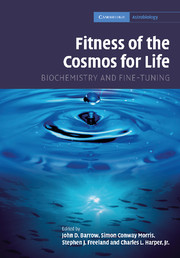Book contents
- Frontmatter
- Contents
- List of contributors
- Foreword: The improbability of life
- Preface
- Acknowledgments
- Part I The fitness of “fitness”: Henderson in context
- Part II The fitness of the cosmic environment
- Part III The fitness of the terrestrial environment
- 10 How biofriendly is the universe?
- 11 Tuning into the frequencies of life: a roar of static or a precise signal?
- 12 Life on earth: the role of proteins
- 13 Protein-based life as an emergent property of matter: the nature and biological fitness of the protein folds
- 14 Could an intelligent alien predict earth's biochemistry?
- 15 Would Venus evolve on Mars? Bioenergetic constraints, allometric trends, and the evolution of life-history invariants
- Part IV The fitness of the chemical environment
- Index
- References
13 - Protein-based life as an emergent property of matter: the nature and biological fitness of the protein folds
Published online by Cambridge University Press: 18 December 2009
- Frontmatter
- Contents
- List of contributors
- Foreword: The improbability of life
- Preface
- Acknowledgments
- Part I The fitness of “fitness”: Henderson in context
- Part II The fitness of the cosmic environment
- Part III The fitness of the terrestrial environment
- 10 How biofriendly is the universe?
- 11 Tuning into the frequencies of life: a roar of static or a precise signal?
- 12 Life on earth: the role of proteins
- 13 Protein-based life as an emergent property of matter: the nature and biological fitness of the protein folds
- 14 Could an intelligent alien predict earth's biochemistry?
- 15 Would Venus evolve on Mars? Bioenergetic constraints, allometric trends, and the evolution of life-history invariants
- Part IV The fitness of the chemical environment
- Index
- References
Summary
The thesis I shall present in this book is that the biosphere does not contain a predictable class of events but is a particular event, certainly compatible indeed with first principles, but not deducible from those principles and therefore essentially unpredictable.
Jacques Monod (1972), Chance and NecessityThe process of crystallization in inorganic nature … is … the nearest analogue to the formation of cells … should we not therefore be justified in putting forward the proposition that the formation of the elementary parts of organisms is nothing but a crystallization and the organism nothing but an aggregate of such crystals?
Theodore Schwann (1847), Microscopical ResearchesThe laws of light as of gravitation being the same [on other planets] … the inference as to the possibility of the vertebrate type being the basis of organization of some of the inhabitants of other planets will not appear so hazardous.
Richard Owen (1849), On the Nature of LimbsIntroduction
In his great classic The Fitness of the Environment (1913), Lawrence J. Henderson examined the fitness of the basic chemical constituents and chemical processes used by living organisms on earth and of the general environment, including the hydrosphere and atmosphere of the earth, and argued that the laws of nature and the properties of matter appear uniquely and maximally fit for life as it exists on earth.
- Type
- Chapter
- Information
- Fitness of the Cosmos for LifeBiochemistry and Fine-Tuning, pp. 256 - 279Publisher: Cambridge University PressPrint publication year: 2007



